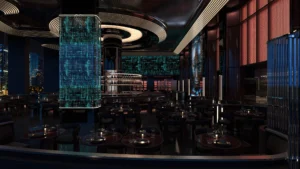What if your next fine dining experience included a culinary co-pilot that could anticipate your taste preferences, adapt your meal in real-time, and paint your surroundings with moving art?
This isn’t a scene from a sci-fi movie. It’s a new reality led by a bold AI restaurant that Dubai residents are now lining up to explore.
Across Dubai, one of the most luxurious and forward-thinking food scenes in the world, technology is now reshaping how we interact with food. But this isn’t just about automation. It’s about imagination, innovation, and the delicate merging of human creativity with cutting-edge technology. It’s about questioning how to use AI in the restaurant business.
Welcome to a New Era of Dining
Dining out used to mean choosing between ambiance or flavor, artistry or authenticity. But today, AI restaurants like WooHoo are proving that we can have it all.
Imagine stepping into a restaurant that is designed to resemble a futuristic space colony, where digital walls shift with every course, offering a multisensory dining experience that transports you from Earth to imagined worlds. This is the immersive journey WooHoo offers, powered by real-time AI’s ability to read the room and adapt both mood and menu.
The Role of AI in the Kitchen
Behind every dish is more than a recipe; it’s a collaboration. Human chefs bring intuition and memory. AI, like Chef Aiman, developed by UAE-based startup UMAI, brings precision, personalization, and endless variation.
Whether it’s helping to fine-tune menus based on seasonal ingredients or optimizing kitchen operations, this culinary co doesn’t replace humans; it elevates them.
Chef Aiman works alongside world-class names, including Chef Reif Othman and Chef Alessandro Miceli, and is informed by protocols designed to keep the creative process both safe and ethically guided. Here, AI is a respectful assistant, not a takeover.
Creating Iconic Recipes Through Collaboration
At WooHoo Restaurant, diners are participants. Each visit offers a dynamic dining experience with evolving flavors, visuals, and sounds.
Whether you’re tasting quail and foie gras from a recipe imagined in partnership with the late Chef Vladimir Mukhin or watching multi-surface projections of digital flora react to your presence, this restaurant offers more than a meal; it tells a story.
With real-time feedback loops, menus evolve based on what resonates with the crowd, crafting original recipes designed to delight even the most discerning palates.
From AI Menus to Ambient Art
The magic of WooHoo is not just in what’s on the plate. It’s in the setting, too. With ambient lighting, AI-generated music, and digital art installations curated in part by digital artist Anton Nenashev, your surroundings shift with your meal. Each course is part of a cohesive, dish-themed, evolving environment.
Reimagining Hospitality at the Heart of Dubai
Positioned at Kempinski The Boulevard, WooHoo overlooks the iconic Burj Khalifa, giving diners stunning panoramic views of the city while inviting them to reconsider everything they thought they knew about food.
And yes, this is still just a restaurant. One grounded in service, excellence, and the timeless joy of eating together. The hospitality group behind WooHoo believes that even with AI, the human touch matters most.
The Evolution of AI in the Global Restaurant Industry
Artificial Intelligence has made significant inroads into many industries, but its impact on the restaurant sector is particularly fascinating. Over the last decade, AI has evolved from being a novelty into a critical tool for improving efficiency, enhancing customer experiences, and reimagining culinary creativity.
Initially, AI in restaurants focused on automation: think robotic arms flipping burgers or kiosks taking orders. But today, AI is influencing much deeper levels of restaurant operations, including data-driven menu engineering, personalized dining recommendations, and even mood-based environment customization.
This transformation is driven by a desire to meet the modern diner’s expectations: experiences that are efficient, personalized, and memorable. With AI, restaurants are now better equipped to deliver that at scale.
Personalization at Scale: How AI Tailors the Dining Experience
One of the most promising uses of AI in restaurants is hyper-personalization. By collecting data on diner preferences, ordering history, dietary restrictions, and even current mood (through surveys or smart sensors), AI systems can curate dining experiences that feel uniquely tailored to each guest.
In casual dining, this might mean suggesting dishes based on your last order. In fine dining, it could mean generating a fully customized tasting menu that aligns with your palate, health needs, and even emotional state.
This level of personalization is no longer reserved for VIP guests. That’s because AI allows restaurants to offer tailored experiences for everyone, making each visit feel more thoughtful and intentional.
AI in Menu Design and Ingredient Sourcing
Behind the scenes, AI plays a crucial role in designing menus that are not only delicious but also operationally efficient and sustainable. By analyzing customer data, seasonal trends, and ingredient availability, AI can suggest new menu items or optimize existing ones.
For instance, AI can recommend reducing the use of ingredients with low turnover or replacing them with more cost-effective and sustainable options. Some platforms even integrate real-time agricultural data to ensure ingredient choices align with regional harvest patterns, reducing waste and supporting local economies.
This approach not only improves profit margins but also allows chefs to stay agile and creative, responding quickly to trends and supply shifts.
Smarter Kitchens: AI-Driven Efficiency in Operations
In the kitchen, AI can act as a silent partner, helping chefs streamline workflows, maintain consistency, and improve food safety. AI-powered kitchen management systems monitor everything from inventory levels to prep times and equipment usage.
For example, predictive algorithms can forecast demand on specific days or during seasonal events, helping kitchens prepare the right amount of food and avoid overproduction. AI can also monitor fridge and freezer temperatures, alerting staff before issues arise and ensuring food safety compliance.

Moreover, robotic kitchen assistants, powered by AI, are now capable of assisting in complex cooking tasks, reducing the burden on human staff and ensuring consistency in high-pressure environments.
AI and Voice Ordering: Accessibility Meets Convenience
Another area of innovation is voice-assisted technology in restaurants. Voice AI allows guests to place orders using natural language; a game-changer for accessibility. Whether used in drive-thrus, self-service kiosks, or mobile apps, voice interfaces make ordering more intuitive and inclusive.
Beyond just capturing orders, AI can also respond with tailored questions to upsell or clarify preferences. For instance, if a customer orders a burger, the system might ask if they’d like it spicy or with a gluten-free bun based on past preferences.
As natural language processing becomes more advanced, these systems are becoming nearly indistinguishable from human staff, while offering faster, more accurate service.
Enhancing Customer Engagement with Predictive Analytics
AI doesn’t stop working when the meal ends. Through predictive analytics, restaurants can anticipate customer behavior, segment their audience more accurately, and design loyalty programs that actually work. In addition, they can use AI for restaurant menu design.
For example, AI tools can identify high-value customers and offer them personalized promotions, exclusive experiences, or early access to new menu items. On a broader scale, data analytics help restaurants understand when and why customer engagement drops off, allowing them to adjust strategies quickly.
Restaurants can also use AI to manage online reviews, analyzing sentiment across thousands of reviews and highlighting areas for improvement in real time.
AI-Powered Sustainability: Greener Kitchens, Smarter Decisions
Sustainability is an increasingly important focus for modern restaurants, and AI is playing a leading role in making operations greener. Smart inventory systems help reduce food waste by tracking expiry dates, managing stock rotation, and suggesting alternative recipes when ingredients are close to spoiling.
AI can also assist in energy management. Sensors placed throughout the restaurant monitor usage of lighting, appliances, and HVAC systems. AI algorithms analyze this data to suggest optimal energy-saving strategies without compromising comfort or efficiency.
By optimizing resources and minimizing waste, AI helps restaurants meet sustainability goals while reducing costs. This will help get the best results for those wondering how to use AI in the restaurant business.
The Ethical Questions of AI in Restaurants
With all the benefits AI brings, there are still important ethical considerations to address. As systems gather more personal data, from dietary habits to biometric feedback, restaurants must handle this information responsibly. Data security, transparency, and consent are all vital concerns.
There’s also the question of labor displacement. While AI can reduce the need for some roles, it also creates demand for new skills, such as AI system management, data analysis, and digital hospitality roles. The challenge lies in retraining staff rather than replacing them.
As AI becomes more integrated into hospitality, maintaining the balance between innovation and human-centered service will be key.
What the Future Holds: Dining in 2030 and Beyond
Looking ahead, AI in restaurants is poised to become even more immersive and intuitive. Developments in augmented reality (AR), brain-computer interfaces, and emotion-sensing wearables may soon allow diners to influence their experience through thought or mood alone.
Imagine walking into a restaurant where your emotional state influences everything from the music to the seasoning of your food. Or menus that change in real time as your conversation or physiology shifts throughout the evening.
While some of this may seem far-off, the groundwork is already being laid. For restaurants willing to embrace change, AI represents not just a set of tools but an entirely new way of thinking about food, service, and connection.
Why It Works: AI Without Losing Soul
The question many ask is how to use AI in the restaurant business without losing tradition, warmth, and soul. The answer lies in thoughtful integration. At WooHoo, AI does not remove the chef’s creativity; it enhances it. And it never replaces the sensory joy of a good meal shared with others. So, make sure you add it to the list of must-do things in Downtown Dubai.
From fine-dining restaurant elegance to late-night explorations of Japanese or Mexican cuisine, this is a place where technology supports taste, and experience is at the heart of everything.
Dining at WooHoo means stepping into the future while still savoring the present. Whether you’re a curious foodie, a tech enthusiast, or simply someone seeking a truly unique night out, this is your invitation to experience something unforgettable.
To reserve your seat at the table, contact us today at info@woohoo.restaurant or +06 48 48 87 40.





